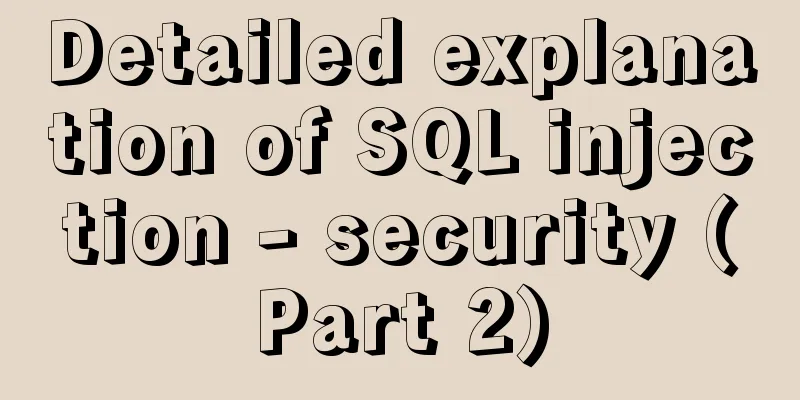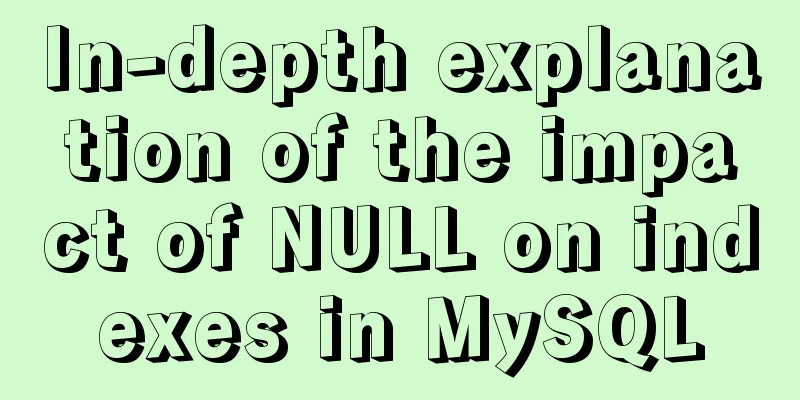The principles and defects of MySQL full-text indexing

|
MySQL full-text index is a special index that generates a list of all words that appear in a certain column of a certain table.
illustrate: Can only be created in MyISAM tables The full-text index can only be searched by separating words with spaces or punctuation marks. Chinese words cannot be searched (there are special applications that support Chinese word segmentation and can search Chinese words, but they are not ideal) Words with less than 3 characters will not be included in the full-text index. You can modify this option by modifying my.cnf
Restart the MySQL server and use
select * from tablename where match(column1,column2) against('word1 word2 word3')>0.001match ... against finds data records that contain at least one of the three words word1, word2, and word3 in the data columns column1 and column2. The data column after the keyword match must be the same as the data column for creating the full-text index. The search terms are not case-sensitive and are not sequence-sensitive. Words with less than 3 characters are usually ignored. The match... against ... expression returns a floating point number as the result of its own evaluation, which reflects the degree to which the resulting record matches the searched word. If no records are matched, or too many matching result records are ignored, the expression will return 0. The expression > 0.001 is used to exclude result records whose match return values are too small.
select *,match(column1,column2) against ('word1 word2 word3') as mtch
from tablename
having mtch>0.01
order by mtch desc
limit 5Find the five most matching records. You cannot use pseudonyms in the where clause, so use having. The Boolean full-text search capability supports the following operators:+word: A leading plus sign indicates that the word must appear at the beginning of each line returned. -word: A leading minus sign indicates that the word must not appear in any of the returned lines. (no operator): In the default state (when no + or – is specified), the word is optional, but the line containing the word has a higher rank. This is similar to how MATCH() ... AGAINST() works without the IN BOOLEAN MODE modification. > <These two operators are used to change the effect of a word on the associated value assigned to a row. The > operator increases its effect, while the < operator decreases it. See the example below. ( ) Brackets are used to separate words into subexpressions. Brackets may be nested. ~word: A leading tilde acts as a negation character, negating the effect of word on the relevance of the line. This is useful for marking "noise" words. Rows containing such words are ranked lower than other rows. word*: Search for words starting with word, only allowed to appear at the end of the word "word1 word" : The given word must appear in the data record, the order must also match, and the letters are case sensitive.
select * from tablename where match(column1,column2) against ('+word1 +word2 -word3' in boolean mode')Boolean searches can only return 1 or 0, and no longer return floating-point numbers indicating the degree of match. Disadvantages of full-text indexing:1. The larger the data table, the better the full-text index effect. Smaller data tables may return some incomprehensible results. 2. Full-text search uses the entire word as the matching object. If a word is transformed (with a suffix or plural form), it is considered to be another word. 3. Only strings consisting of letters, numbers, single quotes, and underscores are considered words. Letters with phonetic symbols are still letters, but C++ no longer considers them as words. 4. Case-insensitive 5. Can only be used on MyISAM 6. The creation of full-text indexes is slow, and the modification of various data with full-text indexes is also slow 7. Does not support Chinese The above is the detailed content of the principles and defects of MySQL full-text indexing. For more information about MySQL full-text indexing, please pay attention to other related articles on 123WORDPRESS.COM! You may also be interested in:
|
<<: How to remove the dividing line of a web page table
>>: Docker uses CMD or ENTRYPOINT commands to start multiple services at the same time
Recommend
Vue realizes the card flip effect
This article example shares the specific code of ...
Record a troubleshooting record of high CPU usage of Tomcat process
This article mainly records a tomcat process, and...
Solution to MySQL error code 1862 your password has expired
The blogger hasn't used MySQL for a month or ...
HTML drawing user registration page
This article shares the specific implementation c...
How to operate MySql database with gorm
1. Setting case sensitivity of fields in the tabl...
How to change password in MySQL 5.7.18
How to change the password in MySQL 5.7.18: 1. Fi...
Getting Started Guide to MySQL Sharding
Preface Relational databases are more likely to b...
Front-end state management (Part 1)
Table of contents 1. What is front-end state mana...
How to clean up data in MySQL online database
Table of contents 01 Scenario Analysis 02 Operati...
Nginx defines domain name access method
I'm building Nginx recently, but I can't ...
mysql+mybatis implements stored procedure + transaction + multi-concurrent serial number acquisition
Database stored procedures DROP PROCEDURE IF EXIS...
Docker file storage path, get container startup command operation
The container has already been created, how to kn...
MySQL 8.0.22 winx64 installation and configuration graphic tutorial
mysql 8.0.22 winx64 installation and configuratio...
7 skills that web designers must have
Web design is both a science and an art. Web desi...
Detailed explanation of the general steps for SQL statement optimization
Preface This article mainly shares with you the g...









